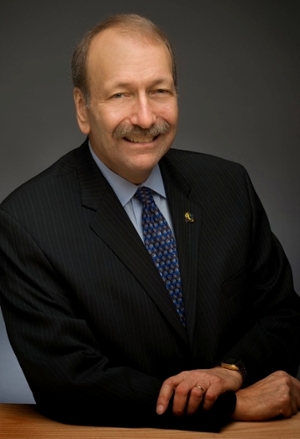We asked the Chancellor what he thinks about sustainability and how it relates to his work at UCSC.
Academic Background:
- Bachelor of Science at the University of Wisconsin-Milwaukee
- Ph.D. in Physics at the University of California, San Diego
- In 2011, he was awarded an honorary Ph.D. in Astrophysics and leadership in higher education from the University of Wisconsin-Milwaukee
Favorite Green Tip: Don't print. I never print...well, almost never. There are only a couple situations where I find printing necessary - boarding passes and for speeches. But aside from those occasional prints, I do a good job of never printing. When I became Chancellor, I set the standard for avoiding printing and now people know not to bring printed materials to meetings with me.
How does sustainability relate to your role at UCSC? What is one cool thing you've done to make UCSC a more sustainable place?
Being the head Banana Slug, I support student initiatives and sustainability as a deeply held value at UCSC. Years ago, a group of students came together with the idea of making UCSC a more sustainable campus; they passed student fee measures that now fund student internships and jobs, allowing sustainability actions to flourish throughout campus. I try to take the students’ actions on our campus and use that to help initiate action at a system-wide level, by raising the issue at University of California Office of the President meetings and among my colleagues on other campuses.
I also initiated the development of the Chancellor's Sustainability Challenge; this Challenge is an opportunity to make significant progress towards reaching our sustainability goals, by collaborating around one sustainability topic. The Challenge for this year is to reduce campus waste so that we can achieve our Zero Waste Goal by 2020 (Pledge here!).
I am also a role model to students, staff, and faculty here at UCSC. I have made many changes to my everyday life like never printing and using a reusable water bottle and mug in order to model living a sustainability life.
How do you practice sustainability in your own life?
I recycle; I don't print unless absolutely necessary and when I do print, I print double sided; and I use a reusable water bottle and travel mug.
Have you had a favorite sustainability moment at UCSC?
There are actually two moments that I can think of. The first one was when I was given this mug, the mug I use everyday. A group on campus, passionate about sustainability, gave it to me and I have used it so much that the label has worn off! My second favorite moment was over the summer when I had a photo shoot with a group of students. We were taking photos that will be used in support of the Chancellor's Sustainability Challenge and the Zero Waste Goal by 2020. I was so impressed by the students that I met at the photo shoot because they were, themselves, sustainable. Most of them brought their own reusable water bottles to the shoot and, after speaking to a lot of them, I knew that they were all there because they were passionate about sustainability.
A lot of people involved in sustainability have brought up the question of how to have challenging conversations with friends, family members, and roommates that may not be as aware or interested in sustainability. How do you deal with those challenging conversations?
Leading by example is one way to begin that conversation. For example, Allison Galloway, the Campus Provost and Executive Vice Chancellor, gave me a reusable hand towel, which made me think about not using the paper towels in the Kerr Hall restrooms. Portraying a good example, like she does, is a great way to get people thinking.
It is also important to think about the different ways people take sustainable action. For instance, my wife does not follow my example; she loves to print hard copies of papers because she takes in more information that way. However, she does many other sustainable things like composting and recycling. Keeping the different actions and priorities of others in mind is important when trying to have that challenging conversation with people. It is also good to ask questions that raise awareness and, more importantly, include others in the decisions being made; that way, you are including them in the change and not forcing change.
In addition, as a leader it is often important for me to get out of the way - to allow for an environment that promotes creativity, collaboration and innovation to flourish. Often sustainability challenges are challenging enough without having unnecessary bureaucratic barriers - so I try to remove myself as a barrier by allowing students, staff and faculty to do what they do best. In the case of sustainability, what they do best is benefiting our campus, our community and our world.

